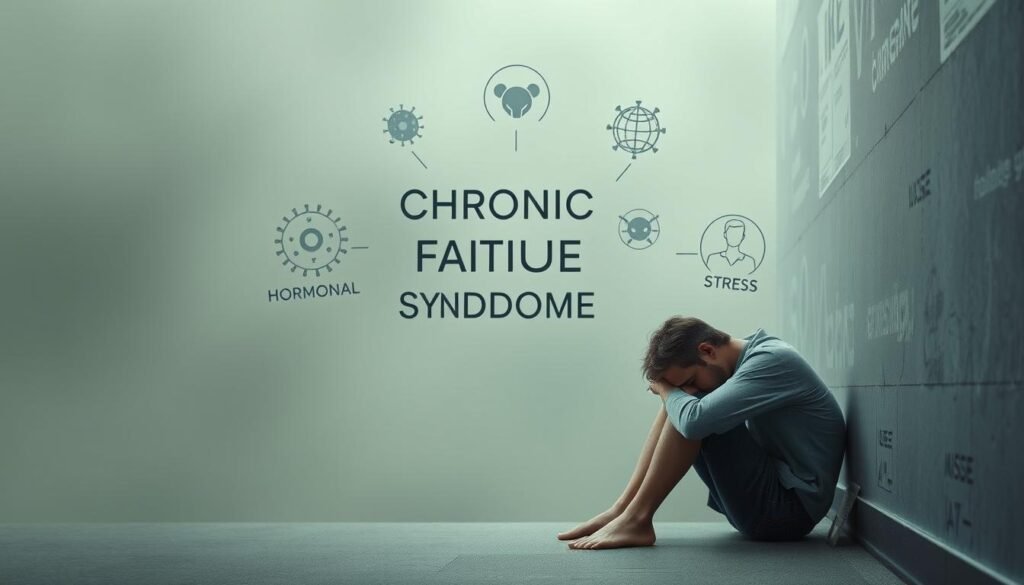Have you ever felt so exhausted that even simple tasks seem impossible? For millions of Americans, this isn’t just a bad day—it’s a daily reality. Chronic Fatigue Syndrome (CFS), also known as myalgic encephalomyelitis, is a complex condition that affects 3.3 million people in the U.S. Yet, 90% of cases remain undiagnosed.
This condition doesn’t just cause tiredness. It disrupts lives, with 25% of patients confined to bed. The symptoms are unpredictable, ranging from severe exhaustion to muscle pain and cognitive issues. Despite its impact, there’s no single test for diagnosis, making it hard for people to get the help they need.
Understanding CFS is crucial. It’s not just about fatigue—it’s a multi-system illness that demands attention. Let’s explore what you need to know about this life-altering condition.
Key Takeaways
- Chronic Fatigue Syndrome affects 3.3 million Americans, with 90% undiagnosed.
- 25% of patients are bedridden due to severe symptoms.
- There is no specific test for diagnosis, making it challenging to identify.
- CFS impacts multiple body systems, causing unpredictable symptoms.
- Early recognition and treatment can improve quality of life.
Introduction to Chronic Fatigue Syndrome
Imagine waking up every day feeling like you’ve run a marathon, even after a full night’s sleep. For people with CFS, this is a reality. Myalgic encephalomyelitis, or ME/CFS, is a complex condition that goes beyond ordinary tiredness. It’s a multi-system illness that affects both physical and mental health.
Historically, ME/CFS was often misunderstood and labeled as “chronic fatigue.” Over time, it has been recognized as a distinct medical condition. Unlike general fatigue, ME/CFS doesn’t improve with rest. Simple tasks like grocery shopping or even getting out of bed can feel impossible.

The condition is more common in women, with rates 2-4 times higher than in men. It often affects teens and adults aged 40-60. Recent studies have also highlighted a connection between ME/CFS and long COVID, as both share overlapping symptoms that may include severe exhaustion and cognitive dysfunction.
Living with ME/CFS can disrupt every aspect of life. Many people with CFS struggle to maintain employment, attend school, or participate in social activities. The condition’s unpredictability makes it challenging to plan even the simplest daily routines.
Understanding ME/CFS is the first step toward better support and treatment. By raising awareness, we can help those affected lead more manageable lives.
What is Chronic Fatigue Syndrome?
Living with a condition that leaves you drained after the smallest effort is more than just tiring—it’s life-altering. Myalgic encephalomyelitis (ME/CFS), often referred to as chronic fatigue syndrome, is a complex disorder that goes beyond ordinary exhaustion. According to the CDC and the Institute of Medicine, ME/CFS is characterized by systemic exertion intolerance, meaning even minor physical or mental activity can lead to severe consequences.

One of the hallmark symptoms of ME/CFS is post-exertional malaise (PEM). PEM occurs when symptoms worsen 12 to 48 hours after even minimal activity, often lasting for days or weeks. This makes it nearly impossible for individuals to maintain a normal routine. Unlike typical tiredness, PEM doesn’t improve with rest, making it a defining feature of the syndrome.
Research suggests that ME/CFS involves abnormalities in the immune system and may have a genetic predisposition. These factors contribute to the body’s inability to recover from exertion. While ME/CFS shares similarities with conditions like fibromyalgia and autoimmune disorders, it is a distinct medical condition with its own set of diagnostic criteria.
Unfortunately, ME/CFS is often misunderstood. Some people mistakenly believe it’s a form of psychological laziness or simply being “too tired.” In reality, it’s a biological dysfunction that affects multiple body systems. Raising awareness about the true nature of ME/CFS is essential for better diagnosis, treatment, and support for those affected.
Symptoms of Chronic Fatigue Syndrome
Many people experience a range of symptoms that go beyond just feeling tired. These symptoms may vary in intensity and can affect multiple body systems. Understanding these signs is crucial for managing the condition effectively.

Core Symptoms
Muscle and joint pain are reported by 80% of individuals. This discomfort can be persistent and debilitating. Recurrent sore throats affect half of those with the condition, often without signs of infection. Digestive issues, similar to IBS, are experienced by 30% of patients, adding to daily challenges.
Additional Symptoms
Headaches resembling migraines are common, often accompanied by sensitivity to light and sound. Lymph node tenderness, even without infection, is another frequent complaint. Temperature dysregulation, such as night sweats or heat intolerance, can disrupt sleep and daily activities.
Many individuals also face comorbidities like POTS, MCAS, and hypermobile joints. These conditions can complicate diagnosis and treatment. Symptoms often fluctuate, with periods of stability followed by “crash” cycles that drain energy for days or even months.
Causes of Chronic Fatigue Syndrome
Understanding the root causes of ME/CFS can help shed light on this complex condition. While the exact origins remain unclear, research points to a combination of biological, environmental, and genetic factors. These elements interact in ways that can trigger or worsen symptoms.

Potential Triggers
Several events or conditions may act as triggers for ME/CFS. Viral infections, such as mononucleosis, are commonly linked to its onset. Prolonged recovery from these infections can increase the risk of developing the condition. Stressful life events, including physical trauma or emotional stress, may also play a role.
Environmental factors, such as exposure to toxins or allergens, have been explored as potential contributors. Additionally, hormonal imbalances and immune system dysregulation are often observed in individuals with ME/CFS.
Risk Factors
Certain groups are more susceptible to ME/CFS. Women are 2-4 times more likely to develop the condition than men. Adolescents and young adults are also at higher risk, particularly those with hypermobile joints. Studies show that hypermobile teens have a 3.5x higher likelihood of developing ME/CFS.
Familial clustering suggests a genetic component, with genes potentially influencing susceptibility. Connective tissue disorders, such as Ehlers-Danlos syndrome, are also linked to ME/CFS. Autoimmune diseases like lupus and Hashimoto’s thyroiditis often overlap with the condition.
Socioeconomic factors contribute to underdiagnosis, particularly in minority communities. Pediatric populations face unique challenges, with prolonged recovery from infections like mononucleosis increasing their risk.
Diagnosis of Chronic Fatigue Syndrome
Identifying ME/CFS can be challenging due to its overlapping symptoms with other conditions. There is no single test to confirm the diagnosis, making it a process of elimination. Doctors rely on a combination of medical tests and clinical evaluations to rule out other potential causes.

Diagnostic Criteria
To diagnose ME/CFS, healthcare providers follow specific criteria. These include severe fatigue lasting at least six months, post-exertional malaise, unrefreshing sleep, and cognitive impairment. Additionally, patients must experience at least one of the following: orthostatic intolerance or muscle/joint pain.
Medical Tests and Evaluations
Several tests are used to rule out other conditions. A complete blood count (CBC) and C-reactive protein (CRP) test can detect inflammation. The antinuclear antibody (ANA) test helps identify autoimmune disorders. Cortisol levels are checked to assess adrenal function.
A tilt-table test is often performed to evaluate orthostatic intolerance. Sleep studies can exclude disorders like narcolepsy or obstructive sleep apnea. Neurological exams may assess small fiber neuropathy, while immune profiling measures natural killer (NK) cell function and cytokine levels.
Referrals to specialists such as rheumatologists, neurologists, or immunologists are common. These experts help confirm the diagnosis and develop a tailored treatment plan. Early and accurate diagnosis is crucial for managing symptoms effectively.
Treatment Options for Chronic Fatigue Syndrome
Managing ME/CFS requires a multifaceted approach tailored to individual needs. While there is no cure, a combination of medications, lifestyle adjustments, and alternative therapies can help improve quality of life. Let’s explore the most effective strategies supported by research and medical guidelines.
Medications
Certain medications can help manage specific symptoms of ME/CFS. For example, pain relievers may ease muscle and joint discomfort, while sleep aids can address unrefreshing sleep. Some patients benefit from low-dose antidepressants to improve mood and energy levels.
Supplements like CoQ10 and D-ribose are often recommended by the CDC to support cellular energy production. However, it’s essential to consult a healthcare provider before starting any new medication or supplement to avoid potential side effects.
Lifestyle and Activity Management
Adapting daily routines is crucial for managing ME/CFS. Pacing activities to avoid overexertion can help prevent post-exertional malaise (PEM). Techniques like adaptive yoga and gentle stretching can improve flexibility without triggering symptoms.
Cognitive Behavioral Therapy (CBT) adapted for ME/CFS can help patients develop coping strategies. While not curative, CBT has been shown to improve mental resilience and reduce the emotional impact of the condition.
Alternative Therapies
Many individuals find relief through alternative therapies. Acupuncture, for instance, has shown promise in reducing fatigue in randomized controlled trials. Massage therapy can also help alleviate muscle tension and promote relaxation.
Meditation and mindfulness practices are effective for managing stress and improving mental clarity. However, it’s important to avoid unproven treatments like ozone therapy or stem cell injections, which can pose significant risks.
Physical therapy techniques designed to be PEM-aware can safely improve mobility and strength. Ongoing research, including NIH clinical trials for drugs like rintatolimod and BC007, offers hope for future advancements in treatment.
Living with Chronic Fatigue Syndrome
Adapting to life with ME/CFS involves more than just managing symptoms—it’s about reshaping your daily routines. This condition requires a thoughtful approach to conserve energy and maintain quality of life. With the right strategies and support systems, individuals can find ways to thrive despite the challenges.

Daily Life Adjustments
Living with ME/CFS often means rethinking how you approach everyday tasks. Pacing activities is essential to avoid overexertion. Breaking tasks into smaller steps and scheduling rest periods can help manage energy levels. Adaptive tools, like mobility aids or ergonomic furniture, can also make daily life more manageable.
Diet and sleep play a crucial role in managing symptoms. Eating nutrient-rich meals and maintaining a consistent sleep schedule can improve overall well-being. Mindfulness practices, such as meditation or gentle yoga, can also help reduce stress and improve mental health.
Support Systems
Building a strong support system is vital for those living with ME/CFS. Family and friends can provide emotional and practical assistance, but education is key. Resources like the CDC’s “I’m So Tired” toolkit can help loved ones understand the condition better.
Online groups, such as Phoenix Rising and MEpedia, offer a sense of community and shared experiences. These platforms allow individuals to connect, share tips, and find encouragement. For severe cases, respite care options can provide temporary relief for caregivers and patients alike.
Counseling can also be beneficial, helping individuals process grief over lost abilities and adapt to their new reality. Advocacy training is another valuable resource, empowering patients to navigate medical discrimination and access the care they deserve.
Chronic Fatigue Syndrome in Children and Teens
ME/CFS doesn’t just affect adults—it impacts children and teens too. About 0.5% of adolescents meet the criteria for this condition, yet diagnosis often takes an average of 18 months. This delay can make it harder for young people to get the support they need.
For kids with ME/CFS, managing school can be a major challenge. IEP or 504 plans can provide accommodations like extended deadlines or reduced workloads. These adjustments help students conserve their limited energy and stay engaged in their education.
Extracurricular activities require careful planning to prevent post-exertional malaise (PEM). Parents and caregivers play a key role in guiding their children to avoid overexertion. The CDC offers training modules for school nurses to better understand and support students with ME/CFS.
Misdiagnosis is a common issue, with symptoms often mistaken for school refusal or depression. Raising awareness about the pediatric aspects of ME/CFS is essential for accurate diagnosis and effective treatment. With the right support, young people can manage their symptoms and thrive.
Research and Future Directions
The future of ME/CFS research holds promise for groundbreaking discoveries. Recent findings from the NIH RECOVER Initiative have identified autoantibodies linked to both long COVID and ME/CFS. This breakthrough could lead to better diagnostic tools and targeted treatments.
Ongoing clinical trials are exploring potential therapies like Rituximab, Ampligen, and BC007. These studies aim to address the root causes of the condition, offering hope for a cure. Additionally, research into microbiome dysbiosis is uncovering how gut health impacts symptoms.
Metabolomic profiling is another exciting area, focusing on identifying biomarkers for accurate diagnosis. Advances in neuroimaging are also revealing brain inflammation patterns, providing deeper insights into the condition’s mechanisms.
Patient-led initiatives, such as those by #MEAction, are shaping research priorities. By involving those directly affected, scientists can focus on the most pressing needs. Together, these efforts are paving the way for a brighter future for individuals with ME/CFS.
Resources and Support for Chronic Fatigue Syndrome
Finding the right resources and support can make a significant difference in managing ME/CFS. Organizations like the Bateman Horne Center and Stanford’s ME/CFS Initiative offer specialist care directories to help patients connect with experts. These clinics provide tailored treatment plans and ongoing care.
Navigating disability benefits can be challenging. Programs like SSDI and LTD offer financial aid to those unable to work due to the condition. Emergency medical alert templates are also available to ensure patients receive appropriate care during crises.
The CDC provides valuable summaries from FDA Patient-Focused Drug Development meetings. These documents highlight the latest research and treatment advancements. For those in need of immediate help, crisis hotlines are available to address suicidal ideation and other urgent concerns.
Global specialist clinic lists and support groups can also provide additional assistance. These resources empower patients to take control of their health and improve their quality of life.
Conclusion
Navigating life with chronic fatigue syndrome requires resilience and the right strategies. By focusing on effective management techniques, individuals can improve their quality of life. Self-advocacy and validation are crucial steps in this journey.
Looking ahead, the future of research offers hope. By 2025, biomarker validation could revolutionize diagnosis and treatment. Participation in registries and clinical trials is essential to drive progress.
Raising awareness and fostering multidisciplinary care approaches can make a significant difference. Together, we can create a brighter future for those affected by this condition.
FAQ
What is Chronic Fatigue Syndrome?
Chronic Fatigue Syndrome (CFS), also known as myalgic encephalomyelitis, is a complex disorder characterized by extreme tiredness that doesn’t improve with rest. It often worsens with physical or mental activity.
What are the main symptoms of CFS?
The core symptoms include severe exhaustion, post-exertional malaise (PEM), unrefreshing sleep, and cognitive issues like memory problems. Additional symptoms may include muscle pain, headaches, and dizziness.
What causes Chronic Fatigue Syndrome?
The exact cause is unknown, but potential triggers include viral infections, immune system issues, and hormonal imbalances. Risk factors may include age, gender, and stress levels.
How is CFS diagnosed?
Diagnosis is based on specific criteria, including persistent fatigue for at least six months and the presence of other symptoms. Doctors may also conduct tests to rule out other conditions.
Are there treatments for CFS?
While there’s no cure, treatments focus on managing symptoms. This may include medications, lifestyle changes, and therapies like cognitive behavioral therapy (CBT) or graded exercise therapy (GET).
How can I manage daily life with CFS?
Adjusting activity levels, prioritizing rest, and pacing yourself can help. Building a strong support system and seeking professional guidance are also important for managing the condition.
Can children and teens develop CFS?
Yes, CFS can affect younger individuals. Symptoms in children and teens may include school absences, difficulty concentrating, and reduced participation in activities.
What research is being done on CFS?
Ongoing studies aim to better understand the causes, improve diagnostic methods, and develop effective treatments. Researchers are exploring links to immune function, genetics, and other factors.
Where can I find support for CFS?
Many organizations offer resources, support groups, and educational materials. Connecting with others who have CFS can provide valuable insights and emotional support.




